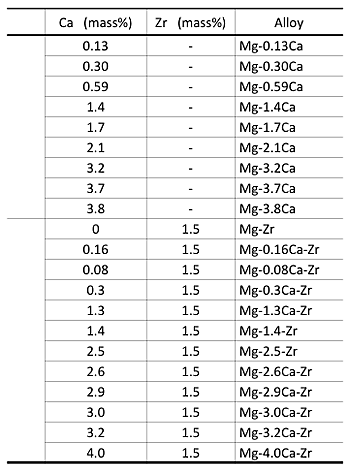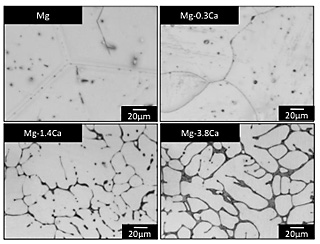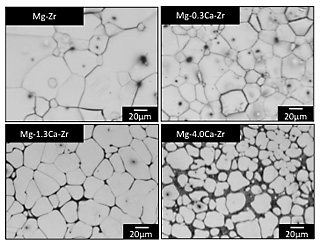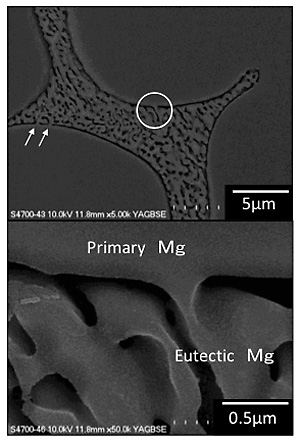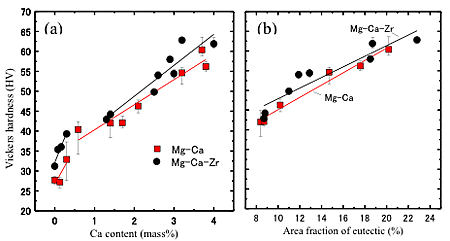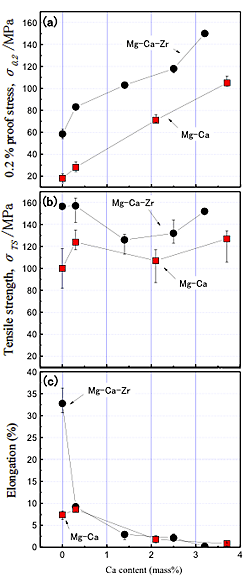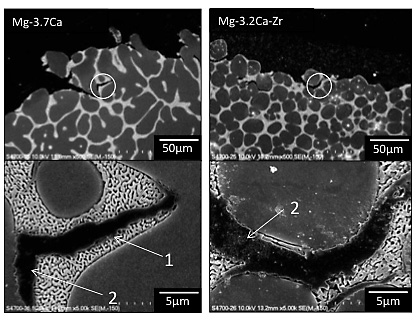Mg-Ca alloy materials have potential as ignition-resistant alloys as well as high-strength alloys through grain refinement with the addition of zirconium. Although some research works have been reported on Mg-Ca alloys, there are many questions remaining unanswered.
In order to gain insight into developing new magnesium alloy materials, Mg-Ca and Mg-Ca-Zr alloys, the composition of which are given in Table 1, were prepared from magnesium (99.93%), calcium (99.9%), a Mg-5Ca master alloy, and a Mg-33Zr master alloy. The microstructures were examined using optical and scanning electron microscopes and tensile tests performed in order to establish the characteristics of cast structures and mechanical properties of alloys of different calcium content.
Shown in Figure 1 are the microstructures of the cast Mg-Ca alloys consisting of primary ![]() -Mg dendrites delineated by eutectic regions (dark areas). The average grain size decreased gradually with calcium content from 550
-Mg dendrites delineated by eutectic regions (dark areas). The average grain size decreased gradually with calcium content from 550![]() m at 0.3%Ca to 380
m at 0.3%Ca to 380![]() m at 4%Ca, indicating that calcium is not an effective grain refiner, while for the microstructures of alloys shown in Figure 2, an addition of zirconium transformed coarse primary
m at 4%Ca, indicating that calcium is not an effective grain refiner, while for the microstructures of alloys shown in Figure 2, an addition of zirconium transformed coarse primary ![]() -Mg dendrites to fine globular grains of approximately 20
-Mg dendrites to fine globular grains of approximately 20![]() m~35
m~35![]() m in diameter, indicating the effectiveness of Zr as a grain refiner in Mg-Ca alloys. Figure 3 shows SEM micrographs of deep-etched eutectic areas, exhibiting a degenerated, interconnected lamellar eutectic structure, comprising of
m in diameter, indicating the effectiveness of Zr as a grain refiner in Mg-Ca alloys. Figure 3 shows SEM micrographs of deep-etched eutectic areas, exhibiting a degenerated, interconnected lamellar eutectic structure, comprising of ![]() -Mg and Mg2Ca phases. However, Zr addition did not alter the morphology of the eutectic. The eutectic area at higher magnifications revealed the eutectic
-Mg and Mg2Ca phases. However, Zr addition did not alter the morphology of the eutectic. The eutectic area at higher magnifications revealed the eutectic ![]() -Mg phase extended from the primary Mg phase, indicating the
-Mg phase extended from the primary Mg phase, indicating the ![]() -Mg phase is a leading phase during eutectic growth. As shown in Figure 4, hardness increased for both Mg-Ca and Mg-Ca-Zr alloys with calcium content, and there was a slope change in hardness increase at about 0.3%Ca, at which the eutectic containing Mg2Ca started to appear at the grain boundaries. Figure 5 shows the comparison of tensile properties between Mg-Ca alloys and Mg-Ca-Zr alloys. The value of 0.2% proof stress also increased for both alloys, showing higher values for Mg-Ca-Zr due to a grain refining effect. The values of tensile strength for Mg-Ca-Zr alloys were also higher than those of the Mg-Ca alloys, while the strength did not improve beyond 0.3%Ca. As shown in Figure 6, fracture occurred owing to the decohesion within the eutectic regions and the cracks propagated though the regions. Thus, an increase in the eutectic regions leads to a reduction in ductility. In particular, the Mg-Ca-Zr alloys, with calcium content as little as 0.3%, showed a significant reduction in ductility, negating the effect of grain refinement. Since eutectic structure exists for calcium content as low as 0.3%, it suggests that the properties of the Mg2Ca phase exert a strong influence on mechanical properties such as tensile strength and ductility.
-Mg phase is a leading phase during eutectic growth. As shown in Figure 4, hardness increased for both Mg-Ca and Mg-Ca-Zr alloys with calcium content, and there was a slope change in hardness increase at about 0.3%Ca, at which the eutectic containing Mg2Ca started to appear at the grain boundaries. Figure 5 shows the comparison of tensile properties between Mg-Ca alloys and Mg-Ca-Zr alloys. The value of 0.2% proof stress also increased for both alloys, showing higher values for Mg-Ca-Zr due to a grain refining effect. The values of tensile strength for Mg-Ca-Zr alloys were also higher than those of the Mg-Ca alloys, while the strength did not improve beyond 0.3%Ca. As shown in Figure 6, fracture occurred owing to the decohesion within the eutectic regions and the cracks propagated though the regions. Thus, an increase in the eutectic regions leads to a reduction in ductility. In particular, the Mg-Ca-Zr alloys, with calcium content as little as 0.3%, showed a significant reduction in ductility, negating the effect of grain refinement. Since eutectic structure exists for calcium content as low as 0.3%, it suggests that the properties of the Mg2Ca phase exert a strong influence on mechanical properties such as tensile strength and ductility.
